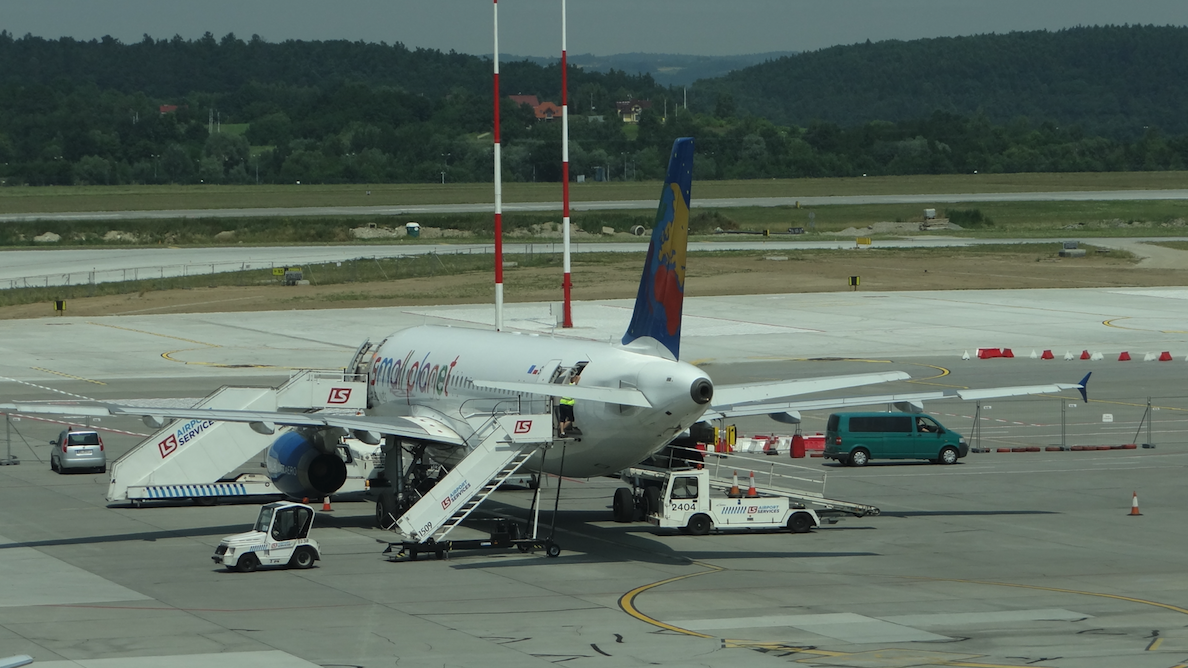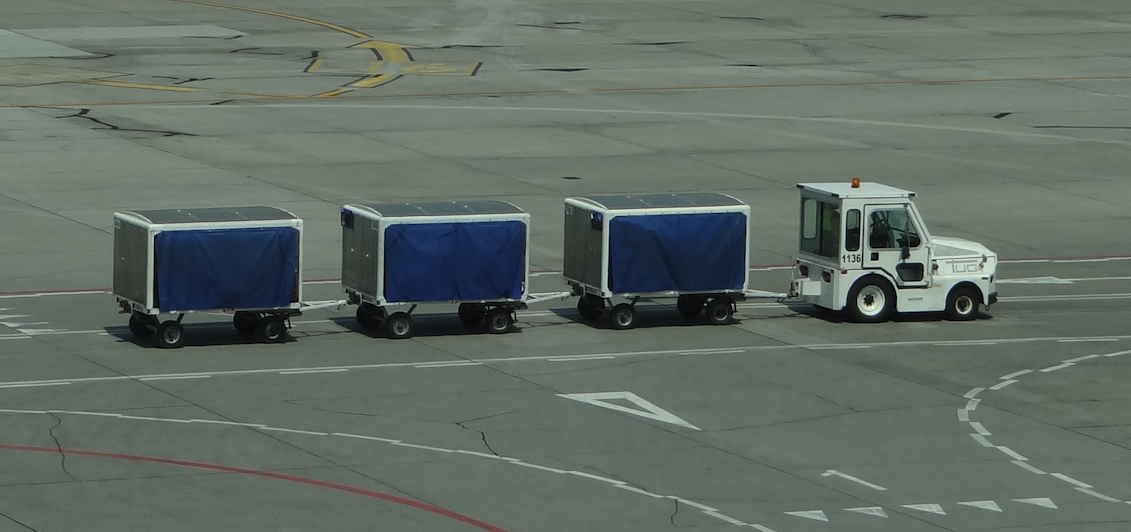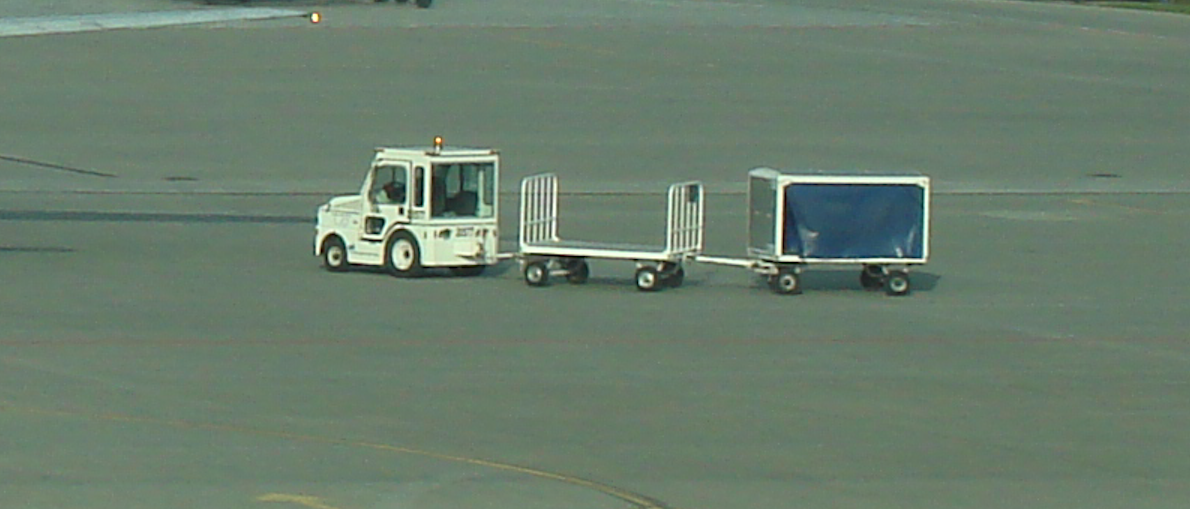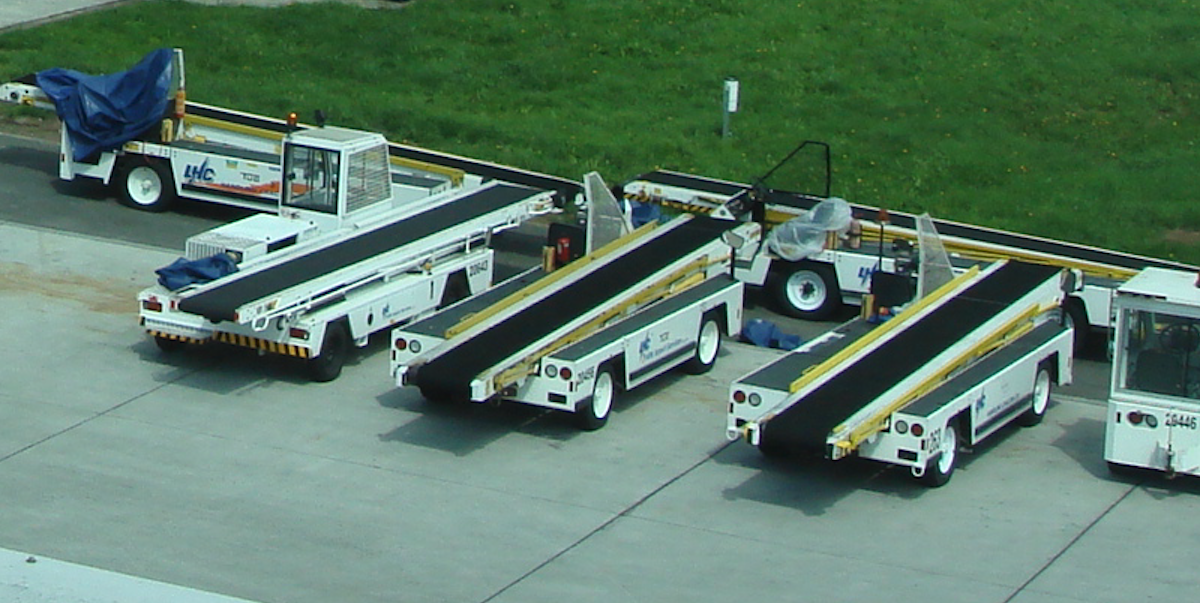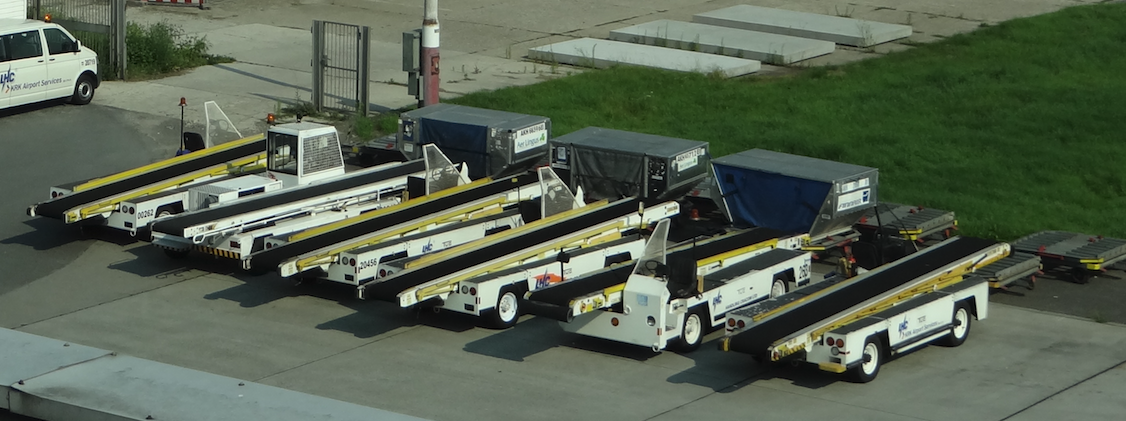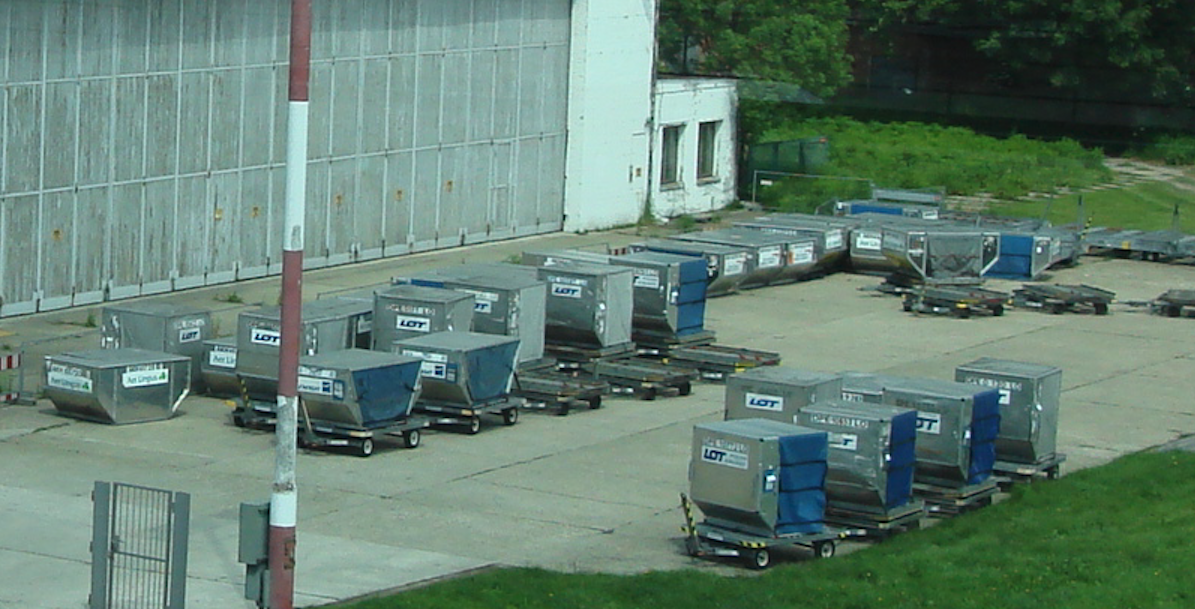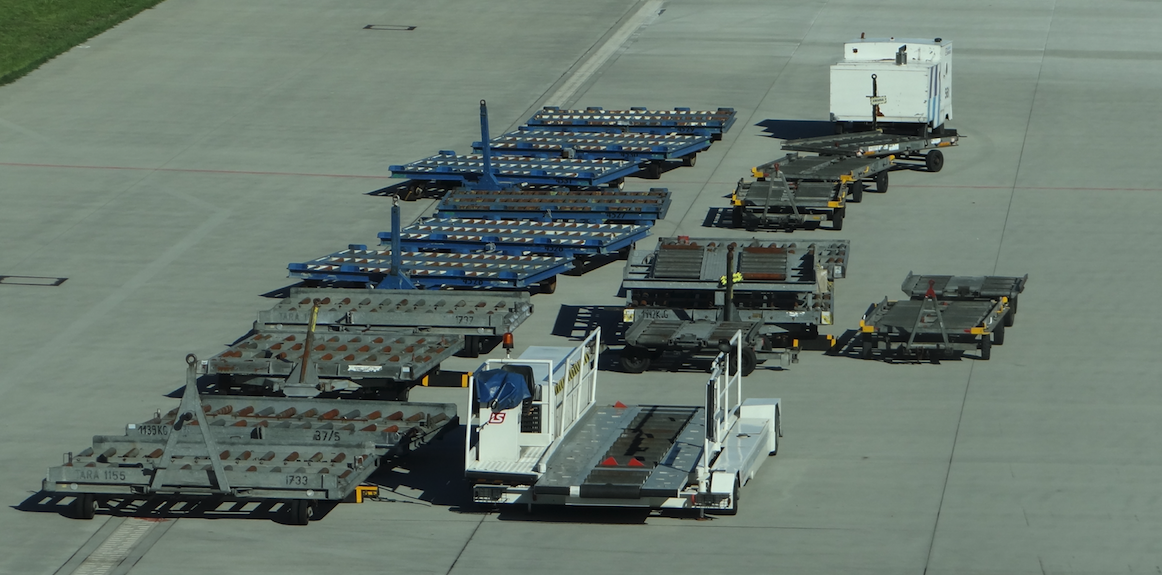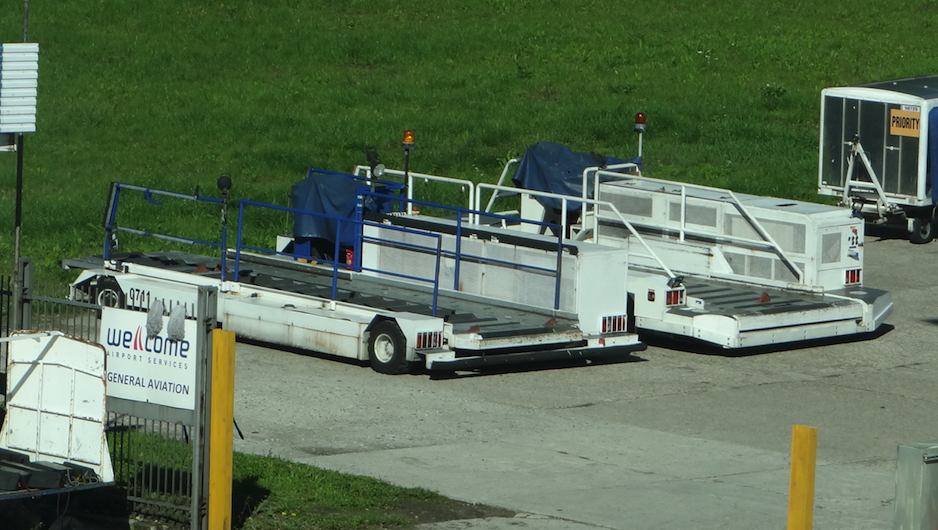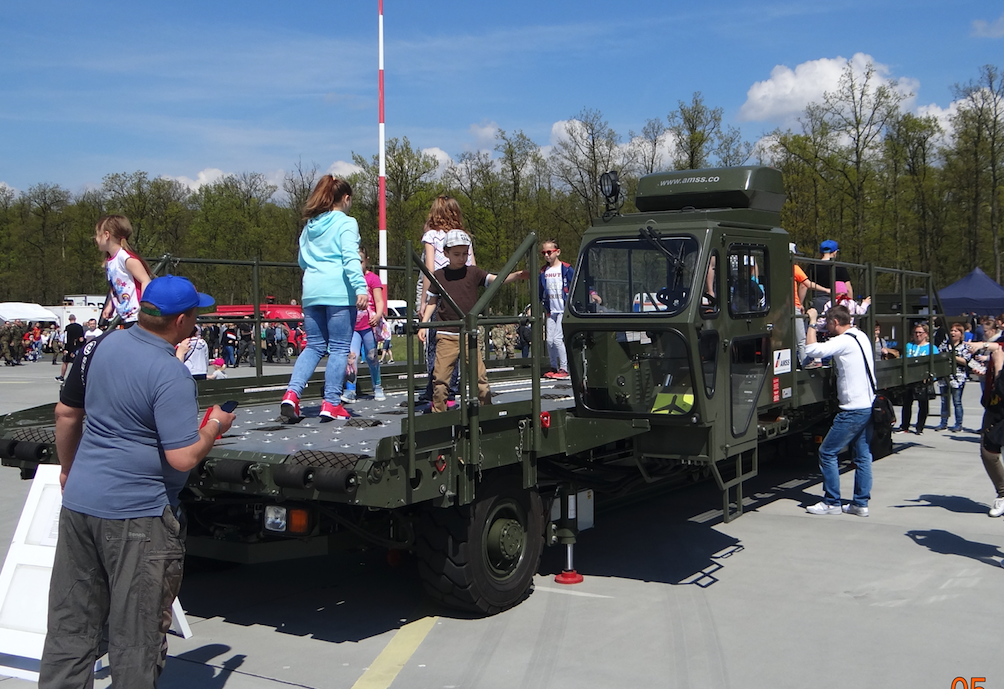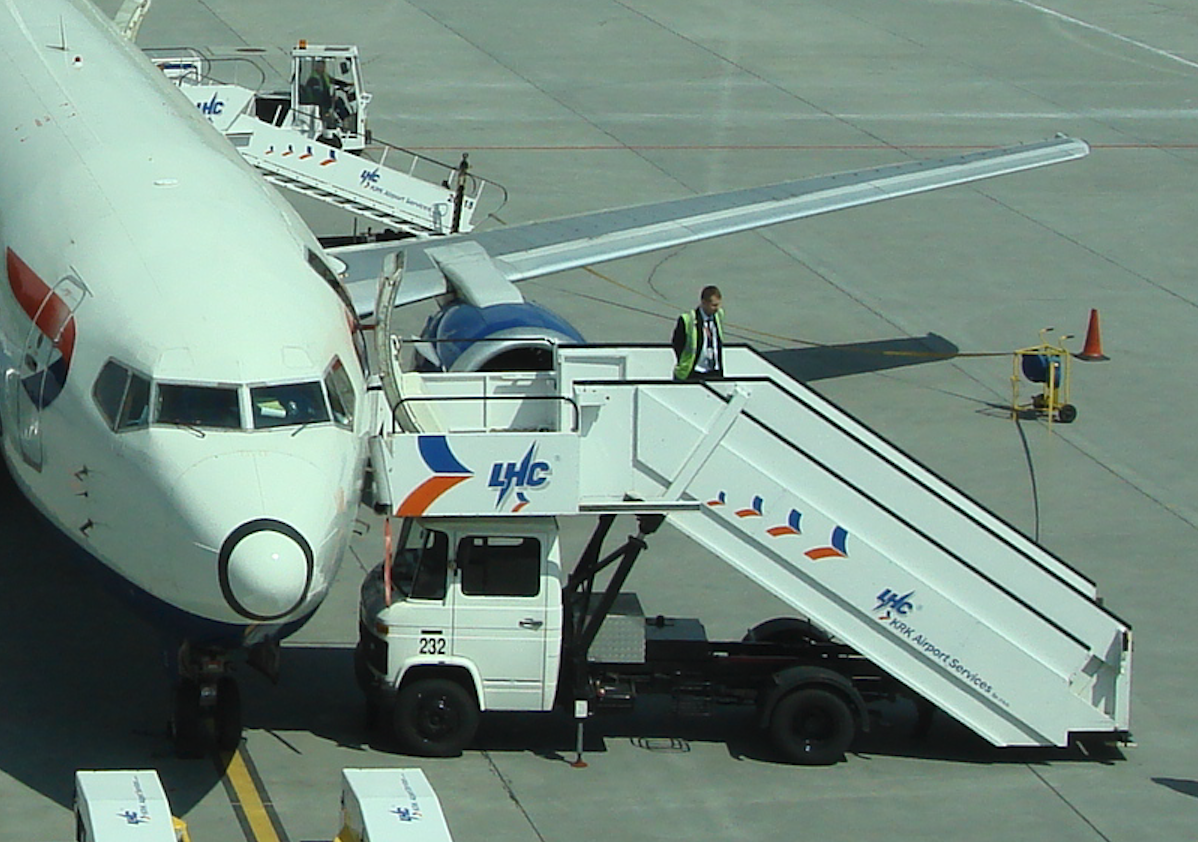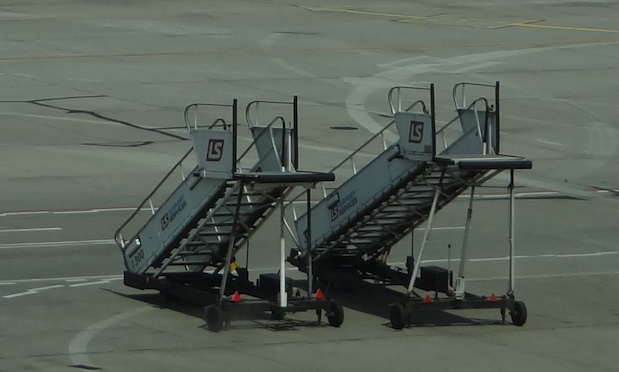Kraków 2017-10-26
Airport equipment.
Luggage trolleys and gangways, i.e. GSP equipment.
GSE – Ground Service Equipment is all equipment designed for ground handling. Some of this equipment has already been discussed in other chapters. Among them, airport tractors, platform buses, airport aggregates, fire brigade vehicles, fuel dispensers. Here we will discuss luggage carts and gangways.
Luggage trolleys.
To begin with, we need to highlight two types of luggage trolleys used at airports. Some are trolleys, let’s call them hotel-type trolleys, intended for transporting luggage of one passenger, for example from a car park to check-in. This topic is basically exhausted. The more that most of today’s suitcases have their own wheels and transport handles.
The second trolleys are trolleys used to transport luggage to and from the plane. And here the topic is wide.
Luggage carts appeared at airport stations with the rise of commercial transport. The carts themselves were taken over from the railway stations. Initially, they were handcarts, later they began to be attached to electric tugboats.
The Polish company ZERMB Wojkowice is a well-known and respected manufacturer of luggage trolleys. Currently, the company offers 14 models of luggage trolleys. Typical load capacity of the trolley is 1,500 kg. Luggage trolleys are designed for the transport of passengers’ luggage, valuable cargo, cargo and other cargo. The construction of the trolleys is hot-dip galvanized and spray painted. All aluminum trolleys will soon enter production. Trolley floors are made of waterproof and non-slip plywood or of steel or aluminum ribbed sheet. The trolley can be covered with polycarbonate plates. There can also be sliding tarpaulins securing the cargo space. The wheels are either solid or pneumatic. The trolley can have manual or automatic hooks.
Luggage at the airport.
The fact that passengers "check in" their luggage at check-in comes from the times when air transport was used only by wealthy people. Therefore, during the check-in, the passenger was taken a suitcase so that he would not carry it. A little later, separate luggage compartments were introduced to which the passenger had no access. The topic of carrying luggage by passengers on board the plane returned in 1985, when the first low-cost airlines appeared. Of course, it was necessary to introduce volume and weight restrictions for this type of luggage, because it is placed in the compartments in the passenger cabin, usually above the heads of passengers.
There are many anecdotes about what happens with our luggage after check-in. Unfortunately, some of them are true. The most famous in the 1960s was this one; – "Breakfast in New York, lunch in Paris, and suitcases in Tokyo." Unfortunately, technical progress and modern management systems have not fully solved these problems.
Let’s remember the rule; Never leave your luggage unattended at the airport. In Poland, the owner is subject to a fine of PLN 500 for left unattended luggage. This procedure resulted from the terrorist threat of modern times.
Our luggage receives a special tag at the check-in desk. The tag has all the necessary information, thanks to which the luggage is to get where it should be. Then our luggage goes literally a level lower, to the automatic sorting room. In Poland, automatic sorting plants are already available in all major ports. The suitcase is placed on a trolley which is supposed to hit the appropriate slide by computer control. Along the way, the suitcase is x-rayed and weighed. During the screening of the suitcase, it may be detained by airport services and cells, and the passenger will be summoned to report to the appropriate services. The weight of one suitcase should not exceed 30 kg, and the trolley will lift a suitcase weighing 32 kg. Thanks to weighing, the aircraft crew knows exactly the weight of the luggage taken on board.
When the suitcase passes through the sorting plant, haldling workers start work. He translates the suitcases into a transport trolley. After the suitcases are packed on trolleys, they are transported under the plane. Here, with the help of a conveyor belt, the suitcases go to the luggage compartment. After landing, the procedure is reversed. At the end, the suitcases go to the receiving belt – a carousel, from where travelers pick them up.
Why are our suitcases lost? First, we are often to blame for ourselves. We check in at the last minute. Then our luggage may not reach our plane on time. Another danger is a combined flight, i.e. with a transfer. It seems to us that we will save ourselves carrying suitcases. The problem is that this second flight may be operated by another handling company and the luggage may be "late" for our second flight. As far as we have control over the check-in time, there is nothing we can do if we wait for the next flight at the airport. It turns out that it would be better to pick up the luggage after the first flight and check it in for the second one. There are also objective conditions. Here is an example: A large plane arrives from the USA at Okęcie Airport. Here, many passengers change to a small plane for a flight to Jasionka Airport. And it turns out that this small plane has no place for all luggage and this luggage will reach Jasionka Airport on another flight.
It happens that during transport on a trolley or on a belt, the suitcase falls, the handle is damaged, the wheel falls off, or the seams break. I don’t think anyone did it on purpose. Therefore, it is better to sharpen the suitcase (wrap it with transparent foil). On the other hand, it is a fact that haldling workers often work under time pressure, precisely because of those latecomers who can never arrive at the airport 30 minutes earlier. Most haldling employees are conscientious people who take their work seriously. Terms of the type that they "play" with suitcases and "throw" them into the hold are just slander. The porter’s job is really hard. It’s worst in hot weather. There is no air conditioning or even ventilation in the luggage compartment of the aircraft. And sometimes the suitcases have to be packed very tightly. Many of them weigh 30 kg.
Baggage duties also include helping mothers with children or the disabled to get onto the plane. It is good when it is a young, beautiful, fragrant woman. It is worse when it is a sick person, weighing more than 100 kg and who took a shower a month earlier.
On the other hand, passengers are so inventive that they try to carry strange objects, such as for air transport: kayak and oars, high jump poles, javelins, sticks with daggers. Some of the suitcases have such a stench that it can tear off your nose, which means that someone has packed food into the suitcase for the whole month. It’s good that shipping companies clearly define what we are not allowed to take with us on the plane.
Conveyors.
Conveyor belts are devices that are designed to help porters deliver suitcases to and from the aircraft luggage space.
Trailers for pallets and aviation containers.
The trailers are intended for the transport of pallets and aviation containers. They are used in particular for forming / dismantling loads sent by air transport. They are also used by forwarding companies when carrying out work related to the transport of goods.
Trailers, depending on the needs, can be equipped with rolling rollers, wheel sets or ball bearings. The entire structure of the trolley is protected against corrosion by hot-dip galvanizing.
For the needs of handling companies and the Polish Air Force, trailers with built-in electronic scales equipped with a label printer, rectifier, weighing terminal charger with a control panel were made.
The Polish company ZERMB Wojkowice is also a producer of this type of trailer for pallets and aviation containers. The offer includes ten basic models. As standard, they withstand a load of 7,000 kg. The company will also make pallets for special orders of recipients and users.
The subject of pallets, lifts and other transport devices is very extensive in cargo transport. Companies that have cargo planes in their fleet have sets of specialized devices for loading and unloading large and heavy goods.
Traps.
The gangways or stairs to the plane allow passengers to board. The word trap itself has several meanings: 1. a pier connecting a ship with a wharf or other ship, 2. a trapdoor in a theater, 3. a competition in shooting targets with hunting shotguns, 4. an extensive lava cover made of basalt or related rocks. We are interested in the first interpretation. As aviation borrowed many terms from shipping, the word trap was adopted.
Trap j.ang. An accommodation ladder is a folding staircase suspended along the ship’s side for ship-to-shore communication or (especially when at anchor) ship-to-other watercraft. The gangway is hung on a gangway davit, and while the ship is moving, it is lifted and folded at the side. As the distance between the deck to which the upper gangway deck is attached and the quay is different at different berths and varies depending on the loading condition of the vessel and the tides. The gangways have a system ensuring the horizontal position of the steps at each inclination of the gangway. The gangway is usually equipped with ropes or railings. In the case of small vessels, the gangway is a narrow footbridge.
In the history of aviation, many commercial aircraft have had their own gangways. A perfect example is the French plane Sud Aviation SE 210 "Caravelle" from 1955. The plane received a fixed staircase at the rear of the plane. The same was done in the CCCP when installing the stairs on the Jakowlew Jak-40 plane.
Integral stairs from the rear of the fuselage could not be matted on all airplanes. Business planes are a perfect example. Most of them have a side entrance door integrated with the stairs. They usually have a few degrees, from two to five.
Another solution that was created in the USA in the 1950s is a retractable staircase from the bottom of the fuselage, right under the plane’s door. They are automatic and self-unfold, including the erection of railings (barriers). Such a staircase was given to, among others, large military planes. Currently, this method is commonly used in Boeing B.737 airplanes.
The producer of gangways (passenger stairs) is the Polish company ZERMB Wojkowice. The stairs are intended for comfortable boarding and disembarkation of the plane’s passengers. The range of the height of the stair deck, depending on the type, ranges from 1.70 m to 5.75 m. The height is calculated from the airport apron. Safety in the event of wind loads is guaranteed by the system of stabilizers. The stairs are adapted to be pulled by a typical airport tractor. The structure of the stairs is protected against corrosion by: hot-dip galvanizing and powder coating, painting with surface paints. There are two versions of platform lifting and lowering: manual pump control and hydraulic control using buttons.
LSP 1 passenger stairs (2.43 – 5.75 m) – The stairs are intended for passenger traffic of the following types of aircraft: – AIRBUS: A300, A310, A318, A319, A320, A321, A330, A340 A380 – BOEING: B707, B727 , B737, B747, B757, B767, B777 – DC: 8, 10 – MD: 11 – TU: 154A, 154B, 204 – IL: 62-M, 86, 96, 114 – As: 42.
LSP 2 passenger stairs (1.70 – 2.80 m) – The stairs are intended for passenger traffic of the following types of aircraft: – AVRO: RJ70, RJ85, RJ100 – BOEING: B737, B200, B300, B400, B500, B600, B700, B800 – DC: 9, 15, 32, 41, 51 – MD: 80, 81, 83 – TU: 134A.
LSP 2 SU passenger stairs (1900 – 3500 mm).
LSP 3 passenger stairs (2200 – 3800 mm) – The stairs are intended for passenger traffic of the following types of aircraft: – AIRBUS: A318, A319, A320, A321, – BOEING: B707-320B / 320C, B727-100 / 100C, B737 classic, B737NG, – DC: 8, 15, 32,41, 51, – TU: 154, – IŁ: 62-M.
LSP 4 passenger stairs – The stairs are intended for passenger traffic of the DASH-Q400 aircraft.The Polish company ZERMB Wojkowice is also a manufacturer of stairs and service platforms for servicing aircraft. They are built specifically for future users. They are made of steel or aluminum alloys.
Wheel chocks.
Wheel chocks are a small element, but extremely important and closely related to the safety of people and equipment. Wedges in parlance are called rats because of their appearance. They are made of wood, rubber, caoutchouc, etc. They should be paired with a rope or a rope so that the wedge is placed in front of the wheel and behind the wheel. The wedge should rest on the ground and the tire tread as much as possible.
Written by Karol Placha Hetman

